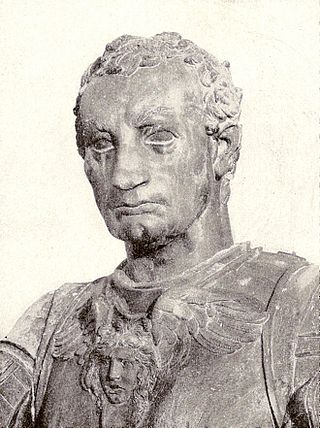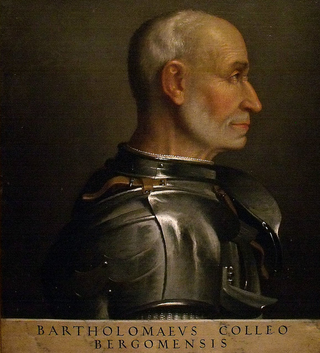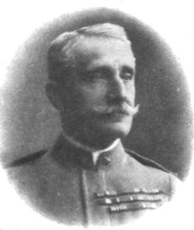Battle
The first clash occurred that same day, when Venetians lost c. 300 infantry to push back a surprise attack on their camp. The following morning the camp was attacked by Piccinino from the West and by the Ghibellines of Valtellina, under Stefano Quadrio, from the East. The Venetians were crushed, most of their commanders being imprisoned. The Venetian losses amounted to 1,800 cavalry and 3,500 infantry, with c. 2,700 prisoners (5,000 casualties and 7,000 prisoners according to other sources).

The Duchy of Milan was a state in Northern Italy, created in 1395 by Gian Galeazzo Visconti, then the lord of Milan, and a member of the important Visconti family, which had been ruling the city since 1277.

Erasmo Stefano of Narni, better known by his nickname of Gattamelata, was an Italian condottiero of the Renaissance. He was born in Narni, and served a number of Italian city-states: he began with Braccio da Montone, served the Papal States and Florence, as well as the Republic of Venice in 1434 in the battles with the Visconti of Milan.

Niccolò Piccinino was an Italian condottiero.

Bianca Maria Visconti also known as Bianca Maria Sforza or Blanca Maria was Duchess of Milan from 1450 to 1468 by marriage to Francesco I Sforza. She was regent of Marche during the absence of her spouse in 1448. She served as Regent of the Duchy of Milan during the illness of her spouse in 1462, as well as in 1466, between the death of her spouse and until her son, the new Duke, who was absent, was able to return to Milan to assume power.

The Battle of Curzola was a naval battle fought on 9 September 1298 between the Genoese and Venetian navies. It was a disaster for Venice, a major setback among the many battles fought in the 13th and 14th centuries between Pisa, Genoa, and Venice in a long series of wars for the control of Mediterranean and Levantine trade.

The Wars in Lombardy were a series of conflicts between the Republic of Venice and the Duchy of Milan and their respective allies, fought in four campaigns in a struggle for hegemony in Northern Italy that ravaged the economy of Lombardy. They lasted from 1423 until the signing of the Treaty of Lodi in 1454. During their course, the political structure of Italy was transformed: out of a competitive congeries of communes and city-states emerged the five major Italian territorial powers that would make up the map of Italy for the remainder of the 15th century and the beginning of the Italian Wars at the turn of the 16th century. They were Venice, Milan, Florence, the Papal States and Naples. Important cultural centers of Tuscany and Northern Italy—Siena, Pisa, Urbino, Mantua, Ferrara—became politically marginalized.

The Torrazzo is the bell tower of the Cathedral of Cremona, Lombardy, in northern Italy.

The Battle on the Po was a battle of the Wars in Lombardy. It occurred in June 1431, on the Po River, near Cremona. The battle was fought between 85 Venetian galleys, sent towards Cremona to support Count of Carmagnola's army, and a somewhat superior number of Milanese galleys. The Venetians were commanded by Niccolò Trevisani.

The Battle of Bosco Marengo(aka Battle of Frascata) was fought in the autumn of 1447.

Cristoforo Moro was the 67th Doge of Venice. He reigned from 1462 to 1471.

The Five Days of Milan was an insurrection and a major event in the Revolutionary Year of 1848 that started the First Italian War of Independence. On 18 March, a rebellion arose in the city of Milan which in five days of street fighting drove Marshal Radetzky and his Austrian soldiers from the city.

Francesco Piccinino was an Italian condottiero.

Alessandro Barbero is an Italian historian, novelist and essayist.

Luigi Torelli was born in Villa di Tirano, in the Valtellina of Lombardy, at the time part of the Napoleonic Kingdom of Italy.
The Battle of Motta was fought in late August 1412 when an invading army of Hungarians, Germans and Croats led by Pippo Spano and Voivode Miklós Marczali attacked the Venetian positions at Motta in Italy and suffered a heavy defeat.
Taddeo d'Este was a condottiere, a freelance military leader, who was known for his defense of the Republic of Venice in 1439 against Milanese forces under Niccolò Piccinino. Unlike many other condottieri of the day, who often changed sides, he served Venice almost exclusively throughout his thirty-year military career. During most of this period Venice was constantly at war with one or more of the neighboring states in northern Italy.

The Treasure Museum of the Basilica of Saint Francis contains a collection of sacred art that is on display in two halls found on the northern side of the Cloister of Pope Sixtus IV which is part of the Sacro Convento in Assisi, Italy. The entrance is found on the second level of the Renaissance cloister behind the apse of the Basilica of Saint Francis, which houses the remains of St. Francis of Assisi. Since 1986 the museum has also displayed a collection of works donated to the Conventual Franciscan Friars by the Secular Franciscan and American art critic, Frederick Mason Perkins, who died in Assisi in October 1955.

The Arese are a prominent family of the Milanese nobility.

Vittorio Camerana was an Italian general who commanded the III Army Corps of World War I. At the end of the war, he was promoted to General of the Army Corps and decorated with the Grand Officer Cross of the Military Order of Savoy.
This page is based on this
Wikipedia article Text is available under the
CC BY-SA 4.0 license; additional terms may apply.
Images, videos and audio are available under their respective licenses.















